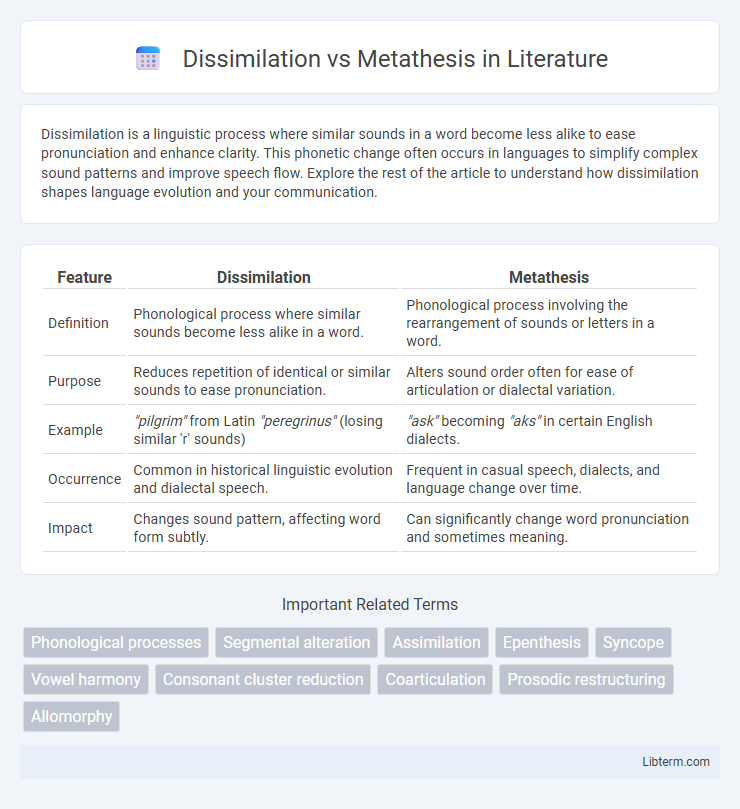Dissimilation is a linguistic process where similar sounds in a word become less alike to ease pronunciation and enhance clarity. This phonetic change often occurs in languages to simplify complex sound patterns and improve speech flow. Explore the rest of the article to understand how dissimilation shapes language evolution and your communication.
Table of Comparison
| Feature | Dissimilation | Metathesis |
|---|---|---|
| Definition | Phonological process where similar sounds become less alike in a word. | Phonological process involving the rearrangement of sounds or letters in a word. |
| Purpose | Reduces repetition of identical or similar sounds to ease pronunciation. | Alters sound order often for ease of articulation or dialectal variation. |
| Example | "pilgrim" from Latin "peregrinus" (losing similar 'r' sounds) | "ask" becoming "aks" in certain English dialects. |
| Occurrence | Common in historical linguistic evolution and dialectal speech. | Frequent in casual speech, dialects, and language change over time. |
| Impact | Changes sound pattern, affecting word form subtly. | Can significantly change word pronunciation and sometimes meaning. |
Introduction to Dissimilation and Metathesis
Dissimilation and metathesis are phonological processes that alter the sounds within words to facilitate easier pronunciation. Dissimilation involves the reduction of similarity between neighboring sounds, often making two identical or similar phonemes more distinct. Metathesis rearranges the order of sounds or syllables within a word, changing sequences to improve fluency or conform to speech patterns.
Definitions and Key Differences
Dissimilation is a phonological process where similar sounds in a word become less alike to improve pronunciation, often by changing one consonant or vowel to a different sound. Metathesis involves the rearrangement or transposition of sounds or letters within a word, altering their original order without necessarily changing the sound itself. The key difference lies in dissimilation reducing similarity between sounds, while metathesis changes sound order, both affecting word phonetics but through distinct mechanisms.
Historical Background
Dissimilation and metathesis are phonological processes with distinct historical backgrounds in language evolution. Dissimilation involves the differentiation of similar sounds within a word to enhance clarity, traceable to Ancient Greek and Latin linguistic patterns. Metathesis, the rearrangement of sounds or syllables, dates back to Old English and Proto-Indo-European languages, illustrating shifts in speech production and dialectal variation over centuries.
Linguistic Mechanisms of Dissimilation
Dissimilation is a phonological process where similar sounds in a word become less alike to enhance distinctness and ease of pronunciation, often affecting consonants more than vowels. This linguistic mechanism operates through types such as progressive, regressive, and reciprocal dissimilation, altering features like place or manner of articulation to reduce phonetic redundancy. Unlike metathesis, which involves the rearrangement of sounds, dissimilation specifically targets the differentiation of sounds to improve perceptual clarity within a phonetic environment.
Linguistic Mechanisms of Metathesis
Metathesis in linguistics involves the reordering of sounds or letters within a word, altering its phonological structure while maintaining its meaning. This mechanism operates through processes like adjacent sound swapping or syllable transposition, often driven by ease of articulation or language-specific phonotactic constraints. Unlike dissimilation, which reduces similarity between sounds, metathesis reshuffles phonemes to optimize pronunciation or morphological patterns in spoken language.
Examples of Dissimilation in Languages
Dissimilation occurs when similar sounds in a word become less alike to ease pronunciation, such as the Latin word "peregrinus" becoming "peregrinus" in some Romance languages. In English, the word "pilgrim" shows dissimilation from Latin "peregrinus," and in Greek, "alyx" becoming "allelon" demonstrates this process. Examples also include the change of Latin "arbor" to Spanish "arbol," where the r sounds lessen similarity for easier speech.
Examples of Metathesis in Languages
Metathesis involves the rearrangement of sounds within a word, as seen in English examples like "ask" pronounced as "aks" and "comfortable" often pronounced as "comfterble." In Arabic, the word for "paints" shifts consonants from *samhar* to *samrah* in some dialects. The phenomenon appears in various languages, including Japanese, where *kuruma* (car) is sometimes pronounced as *kumara* in older forms.
Factors Influencing Each Process
Phonetic environment plays a crucial role in both dissimilation and metathesis by affecting the articulatory ease and perceptual distinctiveness of sound sequences. Frequency of occurrence and lexical position can influence dissimilation, as less common or medial sounds are more prone to change to reduce similarity. In metathesis, dialectal variation and sound system constraints often shape the reordering of phonemes to optimize syllable structure and enhance speech fluency.
Implications for Phonological Theory
Dissimilation and metathesis reveal crucial insights into phonological processes by demonstrating how speakers naturally alter sound patterns to enhance speech clarity and efficiency. Dissimilation involves the differentiation of similar sounds to reduce redundancy, while metathesis reorganizes sound sequences to optimize phonotactic constraints. These phenomena challenge linear phonological models, supporting the need for dynamic, constraint-based frameworks like Optimality Theory that account for surface-level variability and cognitive factors in sound system organization.
Conclusion: Comparing Dissimilation and Metathesis
Dissimilation and metathesis both involve sound changes that transform word pronunciation but differ in mechanisms: dissimilation reduces similarity between sounds, while metathesis rearranges their order. Dissimilation often helps ease articulation by making similar sounds less alike, whereas metathesis can affect syllable structure and rhythm. Understanding these processes illuminates phonological evolution and variation in languages across time.
Dissimilation Infographic

 libterm.com
libterm.com